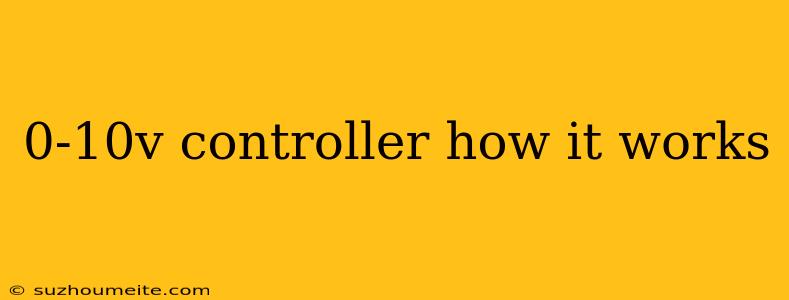0-10V Controller: How It Works
A 0-10V controller is a type of device that is commonly used in industrial automation, HVAC, and lighting control systems to regulate the speed of motors, valves, and other devices. In this article, we will explore how a 0-10V controller works and its applications.
What is a 0-10V Controller?
A 0-10V controller is a device that converts a low-voltage DC signal (typically 0-10V) into a proportional control signal that can be used to control the speed of a device such as a motor, valve, or damper. The controller is usually connected to a sensor or a control device that provides the input signal, and an actuator that receives the output signal.
How a 0-10V Controller Works
The working principle of a 0-10V controller is based on the concept of analog control. Here's a step-by-step explanation of how it works:
1. Input Signal
The 0-10V controller receives an input signal from a sensor or a control device, such as a temperature sensor, pressure sensor, or a manual potentiometer. The input signal is typically a low-voltage DC signal that varies between 0V and 10V.
2. Signal Amplification
The input signal is amplified by the controller's internal amplifier to increase its voltage level and provide a stable output signal.
3. Signal Conditioning
The amplified signal is then conditioned to ensure that it is within the required range for the actuator. This may involve filtering, scaling, or offsetting the signal to match the actuator's requirements.
4. Output Signal
The conditioned signal is then sent to the actuator, which is typically a motor, valve, or damper. The output signal is proportional to the input signal, meaning that as the input signal increases, the output signal also increases, and vice versa.
5. Actuator Control
The output signal from the controller controls the speed of the actuator. For example, if the output signal is 5V, the motor may operate at 50% of its maximum speed. If the output signal is 10V, the motor may operate at 100% of its maximum speed.
Applications of 0-10V Controllers
0-10V controllers are widely used in various applications, including:
1. Industrial Automation
0-10V controllers are used to control the speed of motors, pumps, and valves in industrial automation applications.
2. HVAC Systems
0-10V controllers are used to control the speed of fans, pumps, and valves in heating, ventilation, and air conditioning (HVAC) systems.
3. Lighting Control
0-10V controllers are used to control the brightness of lights in lighting control systems.
4. Process Control
0-10V controllers are used to control the flow rate of fluids, temperature, and pressure in process control applications.
Advantages of 0-10V Controllers
0-10V controllers offer several advantages, including:
1. High Accuracy
0-10V controllers provide high accuracy and precision control over the output signal.
2. Easy Installation
0-10V controllers are easy to install and can be connected to a wide range of sensors and actuators.
3. Flexibility
0-10V controllers are highly flexible and can be used in a variety of applications.
4. Reliability
0-10V controllers are highly reliable and can operate in harsh industrial environments.
In conclusion, 0-10V controllers are widely used in industrial automation, HVAC, and lighting control systems to regulate the speed of motors, valves, and other devices. Their high accuracy, ease of installation, flexibility, and reliability make them a popular choice for many applications.
